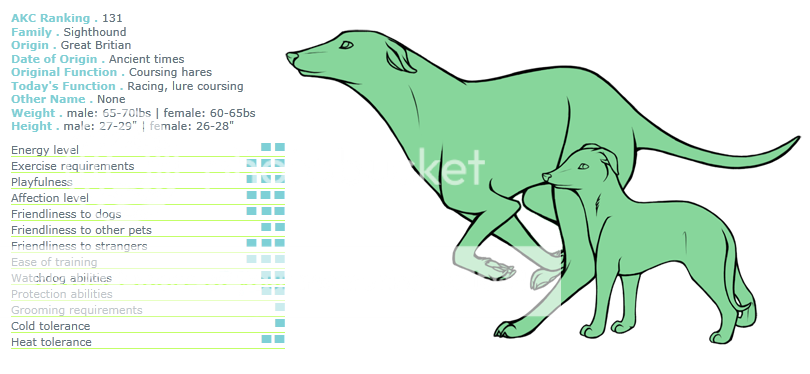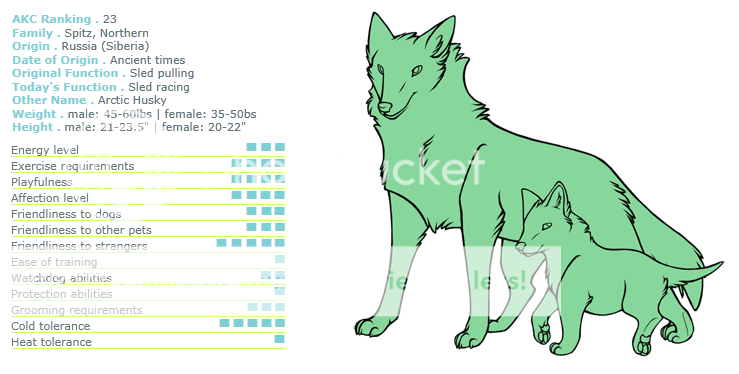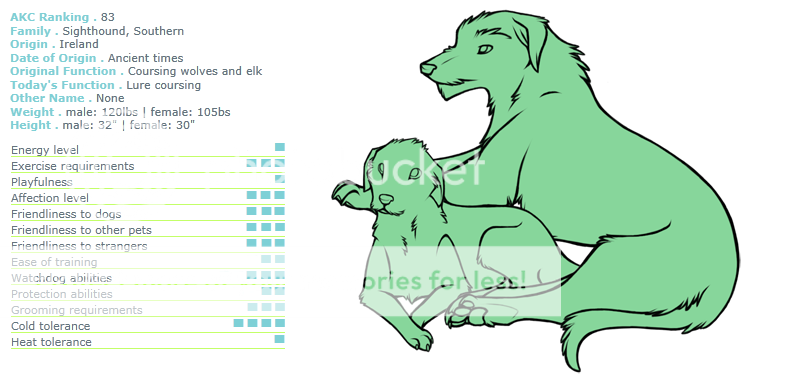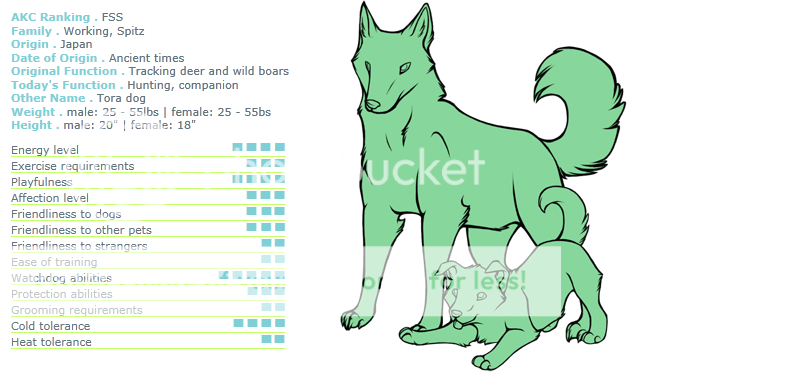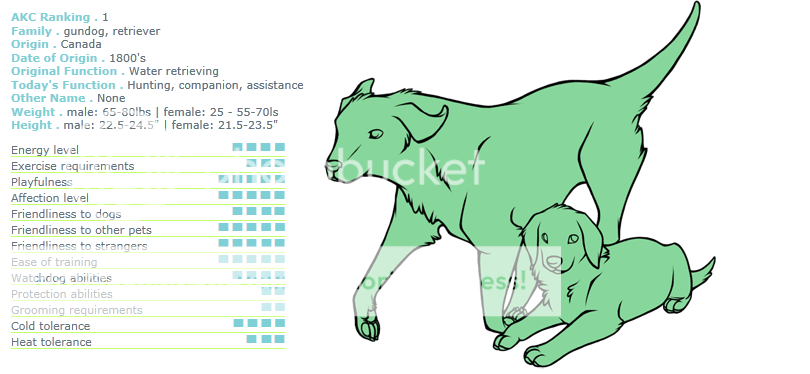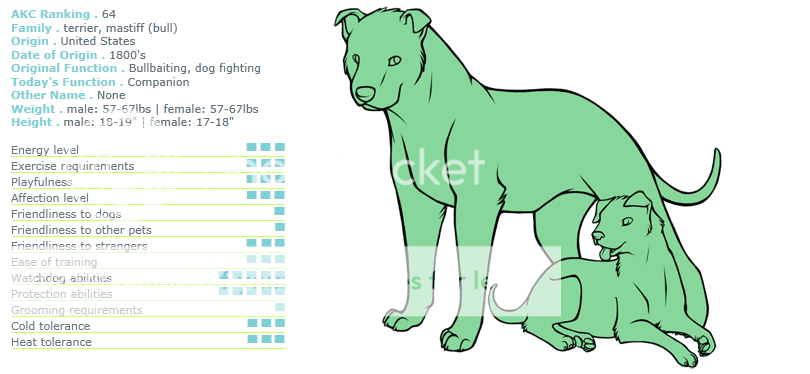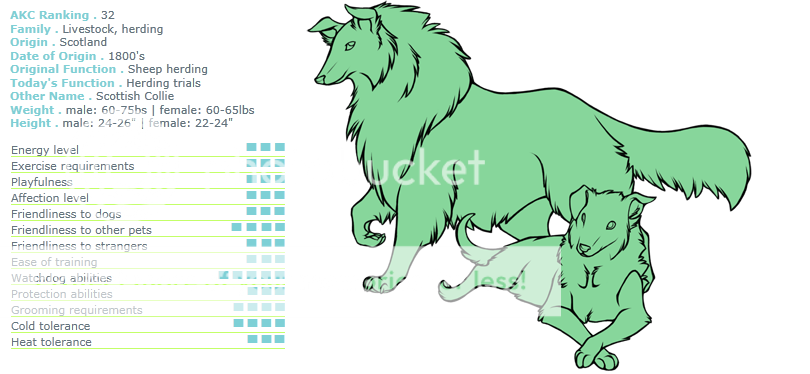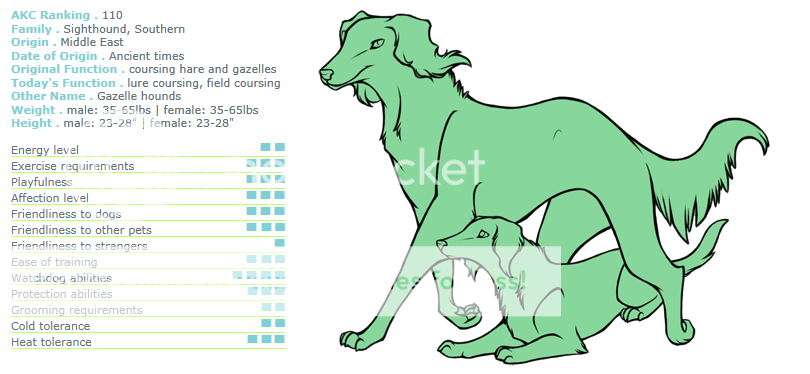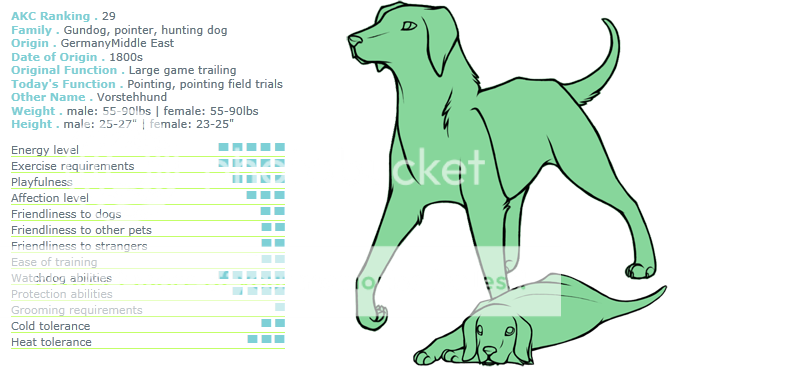|
|
|
|
|
|
|
|
|
 Posted: Wed Feb 09, 2011 7:30 am Posted: Wed Feb 09, 2011 7:30 am
 |
 |
 |
 |
▅▅▅▅▅▅▅▅▅▅▅▅▅▅▅▅▅▅▅▅▅▅▅▅▅▅▅▅▅▅▅▅▅▅▅▅▅▅▅
The Greyhound is a breed of sighthound that has been primarily bred for coursing game and racing, but with recent resurgence of popularity as a pedigree show dog and family pet. It is a gentle and intelligent breed. A combination of long, powerful legs, deep chest, flexible spine and slim build allow it to reach average race speeds of, or in excess of 39 mph.

g r e y h o u n dxxS T A T I S T I C S

g r e y h o u n dxxF A C T S
Breed History
One of the first types of dogs selectively bred by humans was the sighthound, a dog that could run after and catch game by outrunning it. The prototypical sighthound has always been the Greyhound. Greyhound-like dogs have been depicted since ancient Egyptian, Greek, and Roman times. The name Greyhound may come from latin gradus, denoting high grade. By Saxon time, Greyhounds were well established in Britian and were valued by both commoners for their ability to put food on the table and by nobility for the sport of the chase. In1014 the Forest Laws prohibited all but nobility from keeping Greyhounds near royal forests unless they had been "lamed" ; these laws remained in effect for four hundred years. Even when they were repealed. Greyhounds remained the dogs of nobility because with the growing importance of agriculture and domestic animal food sources, the running dog was not economically advantageous, Instead, Greyhounds were used for coursing hare for sport, and during the 1800's coursing became a consuming pastime of the upper class. Track racing, which began in 1926, proved so popular that dogs were bred specifically for short bursts of speed, ultimately resulting in the fastest breed of dog.
Breed Temperament
Known was "the world's fastest couch potato," the Greyhound is quiet, calm, and extremely well-mannered indoors. They are good with other dogs, and other pets if raised with them; outdoors, they tend to chase any small thing that moves. They are reserved with strangers, very sensitive, and sometimes timid. Despite their independent nature, they are eager to please.
Upkeep
They Greyhound needs daily exercise, but it is a sprinter, not an endurance runner. Its needs can thus be met with a chance to run, or by a long walk on the leash. It loves to run and chase outdoors, and can easily run into danger at great speed unless exercised in a safe area.
Form and Function
The ultimate running dog, they Greyhound is built for speed. Its long legs and arched back enable it to contract and stretch maximally while executing the double-suspension gallop. It has tremendous muscle mass and light legs, further enhancing speed. The feet are long and narrow, giving maximum leverage. The long tail serves as a rudder and brake when running at high speed. The coat is short and smooth.
▀▀▀▀▀▀▀▀▀▀▀▀▀▀▀▀▀▀▀▀ ▀▀▀▀▀▀▀▀▀▀ ▀▀▀▀▀▀▀▀▀▀▀▀▀▀▀▀▀▀▀▀
|
 |
 |
 |
 |
|
 |
 |
|
|
|
|
|
|
|
|
|
|
|
|
|
 Posted: Mon Aug 29, 2011 2:50 pm Posted: Mon Aug 29, 2011 2:50 pm
 |
 |
 |
 |
▅▅▅▅▅▅▅▅▅▅▅▅▅▅▅▅▅▅▅▅▅▅▅▅▅▅▅▅▅▅▅▅▅▅▅▅▅▅▅
The Siberian Husky is a medium-size, wolf-like, dense-coat working dog breed that originated in eastern Siberia. The breed belongs to the Spitz genetic family. It is recognizable by its thickly furred double coat, sickle tail, erect triangular ears, and distinctive markings. Huskies were bred by the Chukchi of Northeastern Asia to pull heavy loads long distances through difficult conditions. The dogs were imported into Alaska during the Nome Gold Rush and later spread into the United States and Canada. They were initially sent to Alaska and Canada as sled dogs but rapidly acquired the status of family pets and show dogs.

h u s k yxxS T A T I S T I C S

h u s k yxxF A C T S
Breed History
The Chukchi people of northest Asia developed the breed now known as the Siberian Husky. Its accessory in unknown, but it is of obvious spitz stock, evolved over hundreds of years as a sledge dog for these nomadic people. During the Alaskan gold rush, dogs became a vital part of life in the arctic regions, and dog racing became a favorite source of entertainment. The All-Alaska sweepstakes race, covering 408 miles between Nome and Candle, was especially popular, and in 1909 the first team of Chukchi huskies brought over from Siberia was entered. Smaller and more docile than most of the other competitors, the aroused little admiration, with the exception of one racer who was so impressed he imported seventy to train for the 1910 race. His three teams placed first, second, and fourth and so set the stage for the Siberian Husky's unrivaled dominance in this race.
Throughout the rest of the year, the dogs earned their keep as utilitarian sledders, but it was in 1925 that they gained their greatest acclaim. Teams of huskies raced 340 miles with life-saving serum for diphtheria stricken Nome and were credited with saving the town. A statue in their honor stands in Central Park. The first Siberian Huskies came to Canada, and then the United States, at around this time/ The AKC recognized the breed in 1930. During World War II, many Huskies served in the U.S. Army's Search and Rescue teams, further capturing the public's admiration.
Breed Temperament
Fun-loving, adventurous, alert, independent, clever, stubborn, mischievous, and obstinate all describe the Husky. This breed loved to run and will roam if given the chance. It may be aggressive towards strange dogs, but it is generally good with other household dogs. In fact, it is a very social dog that must have human or canine companionship. Some my howl, dig, and chew.
Upkeep
This is an active dog, bred to run tirelessly for miles. It needs ample daily exercise, either in the form of a long jog or a long run off leash in a safe area. It also loves to pull and enjoys cold weather. It can live outdoors in cool or a cold climate, but ideally it can divide its time between indoors and out.
Form and Function
The Siberian Husky combines power, speed, and endurance, enabling it to carry a light load at a moderate speed over a great distance. It is moderately compact, slightly longer than it is tall, and of definite Northern heritage. It is quick and light on its feet, with a smooth and effortless stride exhibiting both good reach and drive. It has a double coat of medium length, with a soft, dense undercoat and straight, somewhat flat-laying outer coat.
▀▀▀▀▀▀▀▀▀▀▀▀▀▀▀▀▀▀▀▀ ▀▀▀▀▀▀▀▀▀▀ ▀▀▀▀▀▀▀▀▀▀▀▀▀▀▀▀▀▀▀▀
|
 |
 |
 |
 |
|
 |
 |
|
|
|
|
|
|
|
|
|
|
|
|
|
|
|
 Posted: Sun Sep 18, 2011 8:43 am Posted: Sun Sep 18, 2011 8:43 am
 |
 |
 |
 |
▅▅▅▅▅▅▅▅▅▅▅▅▅▅▅▅▅▅▅▅▅▅▅▅▅▅▅▅▅▅▅▅▅▅▅▅▅▅▅
The Irish wolfhound (Irish: Cú Faoil) is a breed of domestic dog (Canis lupus familiaris), specifically a sighthound. The name originates from its purpose (wolf hunting) rather than from its appearance. Irish Wolfhounds are the tallest of dog breeds. A superb athlete and an endurance runner, an old Irish proverb describes the Irish Wolfhound perfectly: "Gentle when stroked, fierce when provoked." Often used as royal gifts, they hunted with their masters, fought beside them in battle, guarded their castles, played with their children, and lay quietly by the fire as family friends. The breed’s recognized colors are gray, brindle, red, black, pure white, fawn and others.

i r i s hxxw o l f h o u n dxxS T A T I S T I C S

i r i s hxxw o l f h o u n dxxF A C T S
Breed History
Dogs of great size are believed to have come to Ireland from Greece by 1500 B.C. In Ireland they became even more imposing, and gifts of these great dogs were made to Rome. The first definite mention of the Irish wolfhound occurred in Rome in A.D. 391. The breed gained fame for its imposing stature and ability in fighting wild animals in arena sports. It was so acclaimed in Ireland that it became the subject of many legends recounting its valor in battle and chase. All large hounds were once known as cu, a term implying bravery. Favored by Irish chieftains for the hunt, it gained its reputation as an unparalleled hunter of wolves and Irish elk. The impressive hounds (often seven at a time) were traditionally given to foreign nobility. This practice, along with the extinction of the wolf in Ireland in the 18th century, contributed to the decline of the breed's numbers.
By the 19th century, Irish wolfhounds were almost extinct in Ireland, and the famine of 1845 virtually decimated the breed. In 1869, Capt. G. A. Graham determined to resurrect the Irish wolfhound, a task he set about by crossing the few existing wolfhounds — in particular one named Bran, thought to be the last true wolfhound in Ireland — with such breeds as the Scottish deerhound as well as the Great Dane, the borzoi and even the Tibetan wolf dog. When first exhibited at a dog show in the 1870s, the reborn wolfhound created a sensation — the same reaction it inspires to this day when first seen. Its commanding appearance draws many admirers, but its popularity is tempered by the practicalities of keeping such a large dog.
Breed Temperament
Aptly known as the gentle giant, the Irish wolfhound is a soft-natured, easygoing breed. It is calm around the house, sensitive, patient, easygoing and sweet. Despite its great size, it is good with children, pets and other dogs. It is reserved with strangers and courageous when the need arises.
Upkeep
The Irish wolfhound enjoys a long walk and a chance to stretch its legs, so it needs daily exercise. At home it needs ample room to stretch out on a soft surface and should not be required to live in cramped quarters. It can develop callouses if allowed to lie on hard surfaces too often.
Form and Function
The tallest of the sighthounds, the Irish wolfhound resembles a rough-coated greyhound, although of more powerful build. Great size is especially valued in the breed. This combination of speed, power and size enables the Irish wolfhound to run down and overpower large prey. Despite its size, the breed should be gracefully built, its gait easy and active, and its head held proudly. The rough coat, which provides protection against the cold and damp, as well as its opponents' teeth, is especially wiry and long over the eyes and under the jaw.
▀▀▀▀▀▀▀▀▀▀▀▀▀▀▀▀▀▀▀▀ ▀▀▀▀▀▀▀▀▀▀ ▀▀▀▀▀▀▀▀▀▀▀▀▀▀▀▀▀▀▀▀
|
 |
 |
 |
 |
|
 |
 |
|
|
|
|
|
|
|
|
|
|
|
|
|
 Posted: Sun Sep 18, 2011 9:52 am Posted: Sun Sep 18, 2011 9:52 am
 |
 |
 |
 |
▅▅▅▅▅▅▅▅▅▅▅▅▅▅▅▅▅▅▅▅▅▅▅▅▅▅▅▅▅▅▅▅▅▅▅▅▅▅▅
The Kai Ken (甲斐犬?, also called the Tora Inu or Tiger Dog) is a breed of dog that hails from Japan where it is a natural monument and has been bred for centuries. It is an extremely rare dog even in its native land and is related to the Japanese Spitz dog type.
Note, the Kai Ken is part of the FFS (Foundation Stock Service®) - breeds on this list are generally rare. The AKC provides this service to allow these purebred breeds to continue to develop while providing them with the security of a reliable and reputable avenue to maintain their records. FSS® breeds are not eligible for AKC registration.

k a ixxk e nxxS T A T I S T I C S

k a ixxk e nxxF A CT S
Breed History
The Kai Ken is a native of Japan. The Kai was wild and was living in the mountains in the province of Kai. They were geographically isolated by mountains and is therefore believed to be the purest of all Japanese breeds. Traditional writings describe the Kai Ken as a natural hunter and Kai's have been known to swim and climb trees in pursuit of game. They were first used by the hunters for tracking deer and wild boars. The Kai was recognized in 1934 by the Japanese Kennel Club. Because of the language barrier there is very limited information on the Kai dog.
It is believed that the first Kai's were brought to the United States in the 1950's. They were brought back to the U.S. by service men in the military, and a pair was also sent to Salt Lake City. The next known arrival of the Kai Ken's was in 1990. In 1990, a four year old male was brought over and shortly after 3 females puppies. In 199, 6 more puppies were brought over and in 1992, one more male puppy was imported. These Kai made up the genetic pool for all the American bred Kai Ken. These are the foundation of the Kai we have today.
There are two great foundation studs given credit for these distinct characteristics found in today's Kai dogs. KAIKURO willed the "shishi-inu-gata" type which is a thicker, stockier dog with a more bear type face. DAIRO famed for his deer hunting, is credited for the thinner longer bodies with foxier faces called the "shika-inu-gata" type.
Breed Temperament
The Kai Ken is intelligent, agile, alert and brave. They are naturally hunters and make good guard dogs, being reserved with strangers but loyal to their families. They are friendly, often good with children and are not usually aggressive towards other dogs. Many love to swim, and have been known to cross rivers and climb trees while chasing their prey.
Upkeep
The Kai is highly intelligent and learns quickly. They seem to learn as fast as the other Japanese breeds if not faster. They are not as independent and are more willing to please their companions. Puppies are born black and fuzzy and develop their brindle markings as they grow and will continue to brindle up to 5 years.
Form and Function
In Japan the Kai is regarded very highly by the Japanese people. The Japanese describe the Kai as a trustworthy guardian and extremely devoted to his master. The Japanese have high respect and admiration for this breed. They say a Kai will lay down its life to protect its master. In Japan the Kai is very loved and protected. The Kai is considered a "Natural Treasure" In Japan. The Kai is an excellent swimmer and climber and have been known to climb trees and swim rivers in pursuit of game.
▀▀▀▀▀▀▀▀▀▀▀▀▀▀▀▀▀▀▀▀ ▀▀▀▀▀▀▀▀▀▀ ▀▀▀▀▀▀▀▀▀▀▀▀▀▀▀▀▀▀▀▀
|
 |
 |
 |
 |
|
 |
 |
|
|
|
|
|
|
|
|
|
|
|
|
|
|
|
 Posted: Sun Sep 18, 2011 10:49 am Posted: Sun Sep 18, 2011 10:49 am
 |
 |
 |
 |
▅▅▅▅▅▅▅▅▅▅▅▅▅▅▅▅▅▅▅▅▅▅▅▅▅▅▅▅▅▅▅▅▅▅▅▅▅▅▅
The Labrador Retriever (also Labrador, or Lab for short) is one of several kinds of retriever, a type of gun dog. A breed characteristic is webbed paws for swimming, useful for the breed's original purpose of retrieving fishing nets. The Labrador is the most popular breed of dog by registered ownership in Canada, the United Kingdom, and the United States (since 1991). It is also one of the most popular assistance dog breeds in Australia, Canada, the United Kingdom and the United States and many other countries, as well as being widely used by police and other official bodies for their detection and working abilities.

l a b r a d o rxxS T A T I S T I C S

l a b r a d o rxxF A CT S
Breed History
The original Labradors were all-purpose water dogs originating in Newfoundland, not Labrador. Not only did the breed not originate in Labrador, but it also was not originally called the Labrador retriever. The Newfoundland of the early 1800s came in different sizes, one of which was the "Lesser" or "St. John's" Newfoundland — the earliest incarnation of the Labrador. These dogs — medium-sized black dogs with close hair — not only retrieved game but also retrieved fish, pulled small fishing boats through icy water and helped the fisherman in any task involving swimming. Eventually the breed died out in Newfoundland in large part because of a heavy dog tax. However, a core of Labradors had been taken to England in the early 1800s, and it is from these dogs, along with crosses to other retrievers, that the breed continued. It was also in England that the breed earned its reputation as an extraordinary retriever of upland game. Initially breeders favored black Labs, and culled yellow or chocolate colors. By the early 1900s, the other colors had become acceptable, although still not as widely favored as the blacks. The breed was recognized by the English Kennel Club in 1903 and by the AKC in 1917. The popularity of this breed has grown steadily; it became the most popular breed in America in 1991 and remains so today.
Breed Temperament
Few breeds so richly deserve their popularity as the Labrador retriever. Devoted, obedient and amiable, the Lab is good with children, other dogs and other pets. It will be a calm house dog, playful yard dog and intense field dog, all on the same day. It is eager to please, enjoys learning and excels in obedience. It is a powerful breed that loves to swim and retrieve. It needs daily physical and mental challenges to keep it occupied, however; a bored Lab can get into trouble.
Upkeep
Labradors are active and sociable dogs. They need daily exercise, preferably in the form of retrieving and swimming. Owners with swimming pools either must fence them out or be prepared to share the pool with dog. The Lab coat sheds water easily. It needs weekly brushing to remove dead hair. Although Labs can live outdoors in temperate climates, they are much happier indoors with their family.
Form and Function
The Labrador is a moderate dog, not extreme in any way. It is square or slightly longer than tall, of fairly large bone and substance. Its broad head and strong jaws should enable it to carry the largest game birds, such as Canada geese. Its heavy body set and strong legs enable it to swim and run powerfully. Its coat, which is short, straight and dense with a soft undercoat, is weatherproof and helps to protect it from icy waters. The Lab is a working retriever and should possess style without over refinement and substance without clumsiness.
▀▀▀▀▀▀▀▀▀▀▀▀▀▀▀▀▀▀▀▀▀▀▀▀▀▀▀▀▀▀▀▀▀▀▀▀▀▀▀▀▀▀▀▀▀▀▀▀▀▀
|
 |
 |
 |
 |
|
 |
 |
|
|
|
|
|
|
|
|
|
|
|
|
|
 Posted: Sun Sep 18, 2011 1:48 pm Posted: Sun Sep 18, 2011 1:48 pm
 |
 |
 |
 |
▅▅▅▅▅▅▅▅▅▅▅▅▅▅▅▅▅▅▅▅▅▅▅▅▅▅▅▅▅▅▅▅▅▅▅▅▅▅▅
The Pit Bull is a medium-sized, solidly built, short haired dog whose early ancestors came from England and Ireland. It is a member of the molosser breed group. There are many variations of this breed such as a the American Pit Bull Terrier, the American Staffordshire Terrier, Staffordshire Bull Terrier, and more - these are refereed to as "bully breeds." Here in Woof!, we base our breed off of the American Staffordshire Terrier because they are recognized by the AKC, but we just call them "Pit Bulls" to avoid confusion.

p i txxb u l lxxS T A T I S T I C S

p i txxb u l lxxF A CT S
Breed History
The Pit Bull Terrier and the Staffordshire Bull Terrier descended from the same lines. The prototype originally sprang from crossing the old type of bulldog with some old terrier types, probably the English Sooth Terrier. The result was aptly called the "bull and terrier," later to be dubbed the Staffordshire Bull Terrier. The dogs gained fame among fanciers of dog fighting, a popular sport despite its having been declared illegal. Their fighting ability gained them passage to America in the late 1800s, where they dominated the fighting "pits." Here they became known as the Pit Bull Terrier, American Bull Terrier and even Yankee Terrier. Americans favored a slightly bigger dog than the English preferred, and with time the two strains diverged.
Docility and tractability have always been vital traits in a powerful dog that must be handled even in the midst of a dog fight; therefore, the Pit Bull evolved to have a sweet and trustworthy disposition around people. Unfortunately, this game dog has too often appealed to people seeking it for its fighting rather than its loving abilities. Often in the midst of controversy, beginning in the 1980s, it sometimes found itself the target of breed-specific laws aimed at banning or controlling certain types of dogs. Despite this, the Pit Bull is currently enjoying one of its most popular periods among people wanting a people- and fun-loving dog.
Breed Temperament
Typically docile and playful with its family, the Pit Bull is also generally friendly toward strangers as long as its owners are present. It is generally very good with children. It is a protective breed and can be aggressive toward other dogs — especially those that challenge it. It is stubborn, tenacious and fearless. For all of its tough persona, the most important thing in life to this breed is its owner's fond attention.
Upkeep
The Pit Bull needs a daily outlet for its energy, preferably in the form of a long walk on leash or a vigorous game in the yard. Though it can live outdoors in temperate climates, this breed is far better suited temperamentally to sharing its family's home. Coat care is minimal. As one of the breeds popularly considered a "pit bull," public acceptance may sometimes be low.
Form and Function
This stocky dog should be muscular, giving the impression not only of great strength for its size but also of grace and agility. Its gait is springy. Its low center of gravity helped it stay on its feet in a fight, and its nimbleness helped it avoid its opponent's teeth. Its own jaws are strong with great power. Its coat is short, close and glossy.
▀▀▀▀▀▀▀▀▀▀▀▀▀▀▀▀▀▀▀▀▀▀▀▀▀▀▀▀▀▀▀▀▀▀▀▀▀▀▀▀▀▀▀▀▀▀▀▀▀▀
|
 |
 |
 |
 |
|
 |
 |
|
|
|
|
|
|
|
|
|
|
|
|
|
|
|
 Posted: Sun Sep 18, 2011 2:22 pm Posted: Sun Sep 18, 2011 2:22 pm
 |
 |
 |
 |
▅▅▅▅▅▅▅▅▅▅▅▅▅▅▅▅▅▅▅▅▅▅▅▅▅▅▅▅▅▅▅▅▅▅▅▅▅▅▅
The Pomeranian (often known as a Pom, or more humorously, Pom Pom) is a breed of dog of the Spitz type, named for the Pomerania region in Central Europe (today part of eastern Germany and northern Poland). Classed as a toy dog breed because of its small size, the Pomeranian is descended from the larger Spitz type dogs, specifically the German Spitz. It has been determined by the Fédération Cynologique Internationale to be part of the German Spitz breed, and in many countries, they are known as the Zwergspitz (~Dwarf Spitz).

p o m e r a n i a nxxS T A T I S T I C S

p o m e r a n i a nxxF A CT S
Breed History
The smallest member of the spitz family, the Pomeranian boasts tough sledding dog ancestors. Exactly when it began to be bred down in size is not known; nor is it known exactly where this miniaturization took place, although Germany, and specifically, Pomerania, is the most likely locale. The breed's likely ancestor was the Deutscher spitz. Only when the breed was taken to England was it dubbed the Pomeranian, but these early dogs were not the "Poms" known today. They weighed as much as 30 pounds and were often white. In fact, the Japanese spitz closely resembles these early Pomeranians and very likely descends from them.
Although the Pomeranian was recognized by the English Kennel Club in 1870, it was not until Queen Victoria brought a Pomeranian from Italy that its popularity grew. The queen's Pomeranians were rather large gray dogs, and even then most fanciers preferred smaller, more colorful specimens. By 1900, Poms had been recognized by the AKC, and dogs were being shown in both England and America in an array of colors. The Pomeranian has continued to be bred down in size; at the same time, an emphasis on coat has led to its unsurpassed "puffball" appearance. This miniature sled dog always attracts admirers and is a very popular pet and show dog.
Breed Temperament
Bouncy, bold and busy, the Pomeranian makes the most of every day. It is curious, playful, self-confident (even cocky) and attentive, ever ready for a game or adventure. It is reserved toward strangers. Some can be aggressive toward other dogs. Pomeranians are alert and aware of changes in their environment and barking at new stimuli can develop into a habit of barking excessively in any situation. They are somewhat defensive of their territory and will thus bark when they encounter any outside noises. They bond quickly with their owners, and can suffer from separation anxiety if not trained to spend time alone.
Upkeep
The Pomeranian is active but diminutive, needing daily exercise but able to meet its needs with indoor games or short walks. Although it has a warm coat, it is too small and too family-oriented to live as an outdoor dog. Its double coat needs brushing twice weekly, more when shedding.
Form and Function
The Pomeranian is a small, square-proportioned, miniature spitz with a cobby, rounded body. It shares the spitz characteristics of small ears, double coat and curled tail. It has an alert, foxlike expression. Its gait is smooth and free with good reach and drive. The soft thick undercoat combined with the longer harsh outer coat, standing off from the body, combine to give the dog a unique puffy appearance. This look is further accentuated by the thick ruff and a head carriage that is naturally up-gazing.
▀▀▀▀▀▀▀▀▀▀▀▀▀▀▀▀▀▀▀▀▀▀▀▀▀▀▀▀▀▀▀▀▀▀▀▀▀▀▀▀▀▀▀▀▀▀▀▀▀▀
|
 |
 |
 |
 |
|
 |
 |
|
|
|
|
|
|
|
|
|
|
|
|
|
 Posted: Sun Sep 18, 2011 2:27 pm Posted: Sun Sep 18, 2011 2:27 pm
|
|
|
|
|
|
|
|
|
|
|
|
|
 Posted: Sun Sep 18, 2011 2:53 pm Posted: Sun Sep 18, 2011 2:53 pm
 |
 |
 |
 |
▅▅▅▅▅▅▅▅▅▅▅▅▅▅▅▅▅▅▅▅▅▅▅▅▅▅▅▅▅▅▅▅▅▅▅▅▅▅▅
The Rough Collie (also known as the Long-Haired Collie) is a long coated breed of medium to large size dog that in its original form was a type of collie used and bred for herding in Scotland. Originating in the 1800's, it is now well known through the works of author Albert Payson Terhune, and through the Lassie novel, movies, and television shows. There is also a smooth-coated variety; some breed organizations, including both the American and the Canadian Kennel Clubs, consider the smooth-coat and rough-coat dogs to be variations of the same breed. Rough Collies generally come in shades of sable, merles, and tri-colored.

r o u g hxxc o l l i exxS T A T I S T I C S

r o u g hxxc o l l i exxF A CT S
Breed History
The derivation of the collie is as obscure as the derivation of its name. One theory of the breed's origins is that it was derived from the same rootstock as the border collie. One theory of the name's origin is that it was derived from a Gaelic word meaning useful, which certainly described the useful farm or stock dogs valued by the Celts who first settled on the British Isles. Although sheep herding and guarding are some of the most ancient of canine services, evidence of the collie dates only from about 1800. Both rough- and smooth-coated "Scotch" collies existed by that time, but they apparently were derived from different crosses. The rough-coated dogs were characteristically smaller and broader headed, and usually black or black and white. As the breed caught the interest of dog fanciers, both rough- and smooth-coated collies became taller and more refined. The rough-coated collie was especially influenced by the progeny of a dog named "old cockie," born in 1867 and thought to be responsible not only for setting type but also for introducing the sable color. Around this same time, Queen Victoria became enthusiastic about the breed; under her sponsorship, its popularity grew not only with shepherds appreciative of its working value but also with members of the upper class, who were enamored of its beauty.
By 1886 a standard was drawn up that still describes the breed as it is today. Meanwhile, as sheep herding became more important in America, settlers brought collies with them to the New World. In 1878, Queen Victoria once again put the breed in the limelight by entering two collies in the Westminster Dog Show. This provided the impetus for America's social elite to join the collie clan, and soon the collie could be found in some of the most prestigious estates in America. Later the collie found a champion in Albert Payson Terhune, whose stories about collies heightened their popularity with people from all walks of life.
Breed Temperament
The collie is gentle and devoted, a mild-mannered friend to all. It is a dog with a working heritage, and it needs daily mental and physical exercise or it can become frustrated. It is sensitive, intelligent and willing to please, although it is sometimes a bit stubborn. It can n** at heels in play. Some may bark a lot.
Upkeep
A good walk or jog on leash or a fun play session is needed every day. Herding is an excellent exercise. The collie can live outdoors in temperate to cool climates, but it is such a family-oriented dog that it is far happier indoors. The coat of the smooth variety needs minimal care; the coat of the rough variety needs brushing or combing every other day, more when shedding.
Form and Function
The collie is an active, lithe, strong dog that combines strength, speed and grace. Its gait suggests effortless speed as well as the ability to change speed and direction instantly, as required in herding dogs. The collie's expression is an important hallmark of the breed, and depends upon the shape and balance of the skull and muzzle, as well as the characteristics of the eyes and ears. It should be bright, alert and intelligent — traits accentuated by a fairly refined head.
▀▀▀▀▀▀▀▀▀▀▀▀▀▀▀▀▀▀▀▀▀▀▀▀▀▀▀▀▀▀▀▀▀▀▀▀▀▀▀▀▀▀▀▀▀▀▀▀▀▀
|
 |
 |
 |
 |
|
 |
 |
|
|
|
|
|
|
|
|
|
|
|
|
|
 Posted: Sun Sep 18, 2011 3:12 pm Posted: Sun Sep 18, 2011 3:12 pm
 |
 |
 |
 |
▅▅▅▅▅▅▅▅▅▅▅▅▅▅▅▅▅▅▅▅▅▅▅▅▅▅▅▅▅▅▅▅▅▅▅▅▅▅▅
The Saluki, also known as the Royal Dog of Egypt and Persian Greyhound, is one of the oldest known breeds of domesticated dog. From the period of the Middle Kingdom onwards, Saluki-like animals appear on the ancient Egyptian tombs of 2134 BC. They have connections both to the Bible and Imperial China. Modern breeding in the west began in 1895 when Florence Amherst imported a breeding pair of Salukis from Lower Egypt and began working to popularize the breed. Salukis were recognized by The Kennel Club in 1923, and by the American Kennel Club in 1929.

s a l u k ixxS T A T I S T I C S

s a l u k ixxF A CT S
Breed History
The Saluki is perhaps the most ancient breed of domestic dog. Evidence of the Saluki can be found on Egyptian tombs dating several thousand years before Christ. The name Saluki may come from the ancient civilization of Seleucia. Arab nomads used Salukis to run down gazelles, foxes and hares in the desert, often with the aid of falcons. Although the Muslim religion considered the dog to be unclean, an exception was made for the Saluki, which was referred to as el hor, the "noble one." As the provider of meat, the Saluki was allowed to sleep in the tents and enjoy the tender attention of its Bedouin master. Salukis were not allowed to breed with non-Salukis, which accounts for their purity throughout the centuries. Because Salukis ranged with their nomadic owners over a wide area of the Middle East, they became widely distributed with great local variation, resulting in the breed's variability today. The Saluki came to the attention of the Western world around 1900 and was recognized by the AKC in 1928. Their numbers have decreased in their lands of origin as a result of the advent of hunting with guns from jeeps. The primary role of the Saluki today is as an exotic companion and show dog, although many of these dogs are still used for hare coursing. The Saluki is also called the Persian greyhound, gazelle hound or tazi.
Breed Temperament
The Saluki tends to be aloof and reserved with strangers. It is extremely devoted to its own family, but it is not particularly demonstrative. The Saluki is very gentle with children, but it may not be playful enough to satisfy most of them. Extremely sensitive, it does not take to rough-and-tumble play or deal well with harsh corrections. Some Salukis can be shy. This breed is very quiet and sedate indoors, seeking out a soft, warm spot. Outside, it runs in great circles at tremendous speeds and will chase any small running animals or fast-moving objects. It may not come when called.
Upkeep
Daily exercise is essential, preferably in the form of free running in a safe, enclosed area. The Saluki's needs can also be met with long leash walks or jogging. Salukis should sleep inside in all but the warmest climates; they do best as indoor dogs with access to a yard. They can play in snow and cold weather but should not be expected to spend extended time in the cold. A Saluki in proper weight is naturally thin; however, this breed tends to be a picky eater, which can result in a very thin-looking dog. Many people not familiar with the Saluki wrongly assume that the dog is not being fed properly!
Form and Function
The Saluki has a general greyhound-like build and should combine grace, symmetry, great speed and endurance. Likwise, it should have the strength to enable it to kill gazelle or other quarry over deep sand or rocky mountains. Its expression should be dignified and gentle, with deep, faithful, far-seeing eyes. Its movement is light. The coat is smooth and silky; the feathered variety has long hair on its ears, tail, between its toes and sometimes on the backs of its legs.
▀▀▀▀▀▀▀▀▀▀▀▀▀▀▀▀▀▀▀▀▀▀▀▀▀▀▀▀▀▀▀▀▀▀▀▀▀▀▀▀▀▀▀▀▀▀▀▀▀▀
|
 |
 |
 |
 |
|
 |
 |
|
|
|
|
|
|
|
|
|
|
|
|
|
|
|
 Posted: Tue Sep 20, 2011 8:52 am Posted: Tue Sep 20, 2011 8:52 am
 |
 |
 |
 |
▅▅▅▅▅▅▅▅▅▅▅▅▅▅▅▅▅▅▅▅▅▅▅▅▅▅▅▅▅▅▅▅▅▅▅▅▅▅▅
The Weimaraner is a dog that was originally bred for hunting in the early 19th century. Early Weimaraners were used by royalty for hunting large game such as boar, bear, and deer. As the popularity of large game hunting began to decline, Weimaraners were used for hunting smaller animals like fowl, rabbits, and foxes. The Weimaraner is an all purpose gun dog. The name comes from the Grand Duke of Saxe-Weimar-Eisenach, Karl August, whose court, based in the city of Weimar (now in modern day Germany), enjoyed hunting.

w e i m a r a n e rxxS T A T I S T I C S

w e i m a r a n e rxxF A CT S
Breed History
Germany has always been a country rich in wildlife, and German dog breeds have gained the reputation as some of the best in the world. The Weimaraner was produced in the 19th century by a concerted effort to create the ideal all-around gun dog that could hunt game of all sizes, including deer and bear. This effort was sponsored by the court of Weimer, and the breed was initially known as the Weimar pointer. Some of the breed's forebears include the bloodhound, red schweisshund and early pointing breeds. The origin of the Weimaraner's distinctive gray color is unknown, but it was an early feature of the breed. The breed's progress was strictly overseen by the German Weimaraner Club. Dogs could not be sold to nonmembers, and membership was hard to obtain. Dogs from nonapproved breedings could not be registered, and poor specimens had to be destroyed. Only when an American gained entry to the club and was allowed to take two dogs back to America in 1929 did the Weimaraner leave its native land. Early American Weimaraners performed so extraordinarily in obedience competitions that they aroused great interest. As more enthusiasts were attracted to the breed, they discovered its great worth as a hunting companion. AKC recognition came in 1943. The breed's beauty and versatility as personal gun dog, pet and competition dog have earned it a steady following.
Breed Temperament
The Weimaraner is bold and rambunctious, sometimes too much so for small children. It loves to run and hunt and can become frustrated and destructive if kept penned up. It can be stubborn or headstrong. It functions best with an active owner who enjoys outdoor activities and wants a fun-loving companion. Owners need patience and consistent, firm yet kind training, as this breed is particularly rambunctious during the first year and a half of its life. This breed is known for having a penchant for stealing food from table and counter tops whenever given the chance. Like many breeds, untrained and unconfined young dogs often create their own fun when left alone, such as chewing house quarters and furniture. Thus, many that are abandoned have behavioral issues as a result of isolation and inferior exercise.
Upkeep
Daily strenuous exertion is a must for the Weimaraner. This is not a breed for city life unless its owner is a jogger. It needs to stretch its legs, run and explore in a large, safe area. It needs a yard at home, and although it can live outdoors in warm climates, it is not suited for cold nights outside. As a social dog, it does best when it can divide its time between indoors and out. Coat care is minimal: occasional brushing to remove dead hair.
Form and Function
The Weimaraner is built to hunt with great speed and endurance and combines grace, stamina, raciness and an alert demeanor. It has find aristocratic features, with a kind expression. The gait is smooth and effortless. The short sleek coat is noted for its unique gray color.
▀▀▀▀▀▀▀▀▀▀▀▀▀▀▀▀▀▀▀▀▀▀▀▀▀▀▀▀▀▀▀▀▀▀▀▀▀▀▀▀▀▀▀▀▀▀▀▀▀▀
|
 |
 |
 |
 |
|
 |
 |
|
|
|
|
|
|
|
|
|
|
|
|
|
 Posted: Tue Sep 20, 2011 8:55 am Posted: Tue Sep 20, 2011 8:55 am
|
|
|
|
|
|
|
 |
|
|
|
|
|
|

